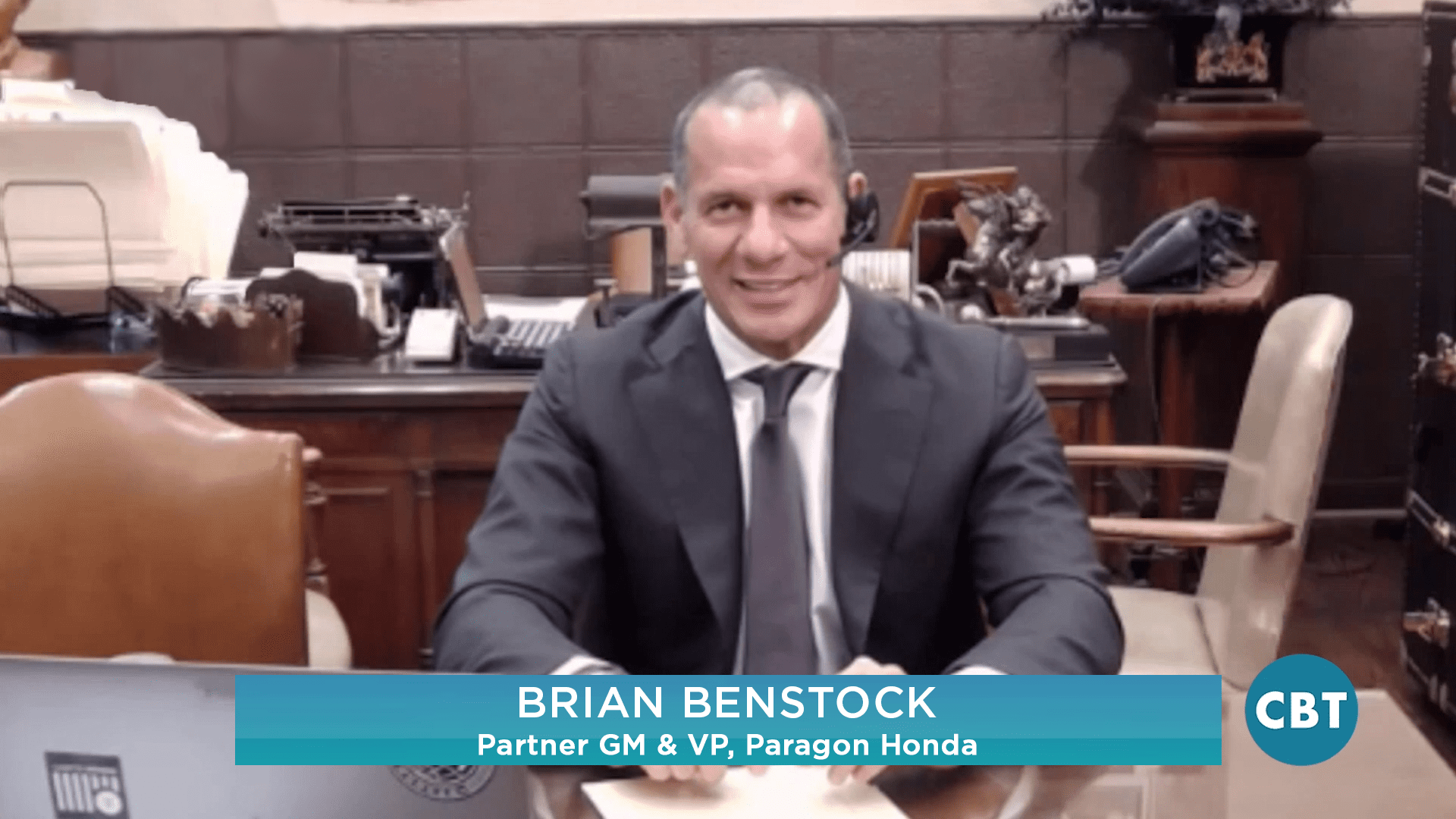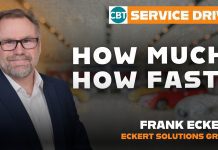We recently welcomed back Partner GM and VP of Paragon Honda, Brian Benstock to the CBT studios. Earlier this year, Brian presented a key study at the 2019 Google Think Auto conference, which discussed several industry trends including the importance of marketing attribution. In this segment, Brian asks the important question, “Can Your Dealership Attribute Every Dollar Spent on Advertising?”
Jim Fitzpatrick: Hi, everyone. I’m Jim Fitzpatrick. Thanks so much for joining us on CBT News. Today, I am joined by the one and only, Mr. Brian Benstock, VP GM partner at Paragon Honda. I know that you know this individual. He’s all over the auto industry, and he’s an all-around great guy. Brian, thanks so much for joining us again on CBT News.
Brian Benstock: Jim, thanks for having me.
Jim Fitzpatrick: Yeah, so you were the man out there at Google Think Auto 2019. Talk to us about that event, the purpose of it, and then what you spoke about.
Brian Benstock: Well, it’s a tremendous event. In fact, I think it’s Google’s largest Think event globally. I was honored to be asked to give a little bit of a case study history of what we’re doing at the dealership, what we see, what trends we see, and what specifically we’re doing to combat that. My presentation was on the attribution revolution. There’s that saying that only 50% of my advertising works, I don’t know which 50%, ha ha. Well, you can’t joke like that anymore. You really need to have attribution, because especially in a store like ours, the advertising budget annually is millions of dollars. You can’t have half of that unaccounted for.
Jim Fitzpatrick: Right, and nowadays there’s-
Brian Benstock: We want to have accountability for every dollar, so we spoke specifically to those numbers and that [inaudible 00:01:45].
Jim Fitzpatrick: In a digital age, there’s no reason anymore that somebody would make a statement like that, right? Even jokingly, to say, “I don’t know where 50% of my budget is effective.” Because of digital, we know what’s working.
Brian Benstock: It’d be a shocking thing to admit today, when you’ve got a budget that a couple hundred thousand dollars a month, you want to hold the advertisers accountable. I think that’s one of the real benefits of digital, is that you can have the level of accountability that you’re looking for, and we certainly look for that accountability from our advertisers.
Jim Fitzpatrick: While you were out there you made this statement that you decreased your cost per car on advertising from over $600 to about $175 bucks year over year. Talk to us about that.
Brian Benstock: Well, we sold, last year Paragon sold about 10,500 retail cars, and we figure that took about 44,000 store visits. We have attribution on 18,762 of those store visits, we can track back to digital. That’s a pretty good count, 18,762. More specifically though, we have 44% of that traffic came from YouTube. The media, consumers are not consuming this media, they’re consuming it differently. Even better part of that 42% that came from YouTube, is that it accounted for only 8% of our budget. So when you’ve got 8% of the budget driving nearly 50% of the traffic, that drops your cost for advertising transaction down significantly. In our case, it was down to about $175 a car versus the industry average is $600 a car.
Jim Fitzpatrick: Wow. Today, every dealer that’s listening to this and manager goes, “This is what it’s all about. It’s all about running a dealership more efficiently than the way that our parents ran the dealership.” Maybe in my case my grandparents. But, you know what I’m saying? Because it’s really about efficiency nowadays, right? It’s all about … because you’re not making it on the front end, and you’re not making it, even used cars is challenged now. You got to run that dealership cheaper, and advertising always was at the top of the expense column, right?
Brian Benstock: Yeah, it was and it is. But, we’re under attack to look how to make cuts and make changes. Again, we don’t mind spending money if we know we’re going to get a decent return on it. In the past, it was a little bit more difficult to measure than it is today. Today, with some of the [inaudible 00:04:06] technology that’s available, you have a real good idea on how many store visits you’re getting. Certainly you can tell how many customers are going to your website, and you can also tell where they’re coming from. So it gives you really good attribution trail for us to follow.
Jim Fitzpatrick: Sure. You mentioned that consumers want to shop on their terms, and also want control over the process. Can you drill down on that a little bit?
Brian Benstock: Well, yeah, I think it’s shared control of the process, right? They don’t necessarily want control. What do we like about Uber? You can grab your phone, you can pick the driver, you can pick the vehicle, you can pick the time, you can select a driver based on his or her driving record and their timeliness. So that gives you some sort of shared control as opposed to standing there with your arm up in the air waiting for someone to pick you up. Think of Peloton. I’m a Peloton biker, and think of that compared to going to a SoulCycle. If I go to SoulCycle and there’s a 6:30 class in Manhattan and I get there five minutes late I’m locked out. Well, I’ll never miss a Peloton class. Again, I can pick the instructor, I can pick the music, I can pick the intensity, I can pick the length of the class, and it’s whenever it’s convenient for me. So I think if that’s a shift, and it is, how do we benefit from that shift? How do we take advantage of that?
Brian Benstock: Again, Netflix is another example. If you watch the TV show 20 years ago, if you missed it at 6:30, unless you recorded it, and I never, to this day, learned how to use a VHS and record something in advance. If you missed it, you missed it. Today, you can watch what you want, when you want, whenever you want, on whatever device you want. So we thought, “How do we apply that automotive? How do I get to be able to serve customers when they want, where they want, how they want?” Some of the things that we’re doing with pick up and delivery, I think we’re really delivering that for customers.
Jim Fitzpatrick: Yeah, talk to us … talk to us about that, because the dealers and managers that are listening to you speak about this topic right now, are saying, “Brian, be more specific, how do you bring that Amazon or that Uber approach to retail automotive?”
Brian Benstock: Well, we’ve got a couple of things in common, right? Every one of us has a cell phone, and every one of us has the cell phone on. We thought, “If [inaudible 00:06:14] at Starbucks was going to put a Starbucks in Manhattan, where would he put it?” And the answer is, “Well, he’d put it on every corner.” So we thought, “How do we put a dealership on every corner?” Well, that’s really not cost effective. But, then you think, “There is a cell phone on every single square inch of real estate in Manhattan and Queens, and what if we made all these services that are available at a dealership available to the consumer on the phone?” I’m not talking about just being able to shop or call, of course you can do that. But, I’m talking about what if you were able to push a button and have a test driver and have it brought directly to you. What you if you pushed a button and had your car picked up for service, serviced, and brought back to you?
Brian Benstock: We were speaking before and consumers are using their car only about 4% or 5% of the time. So why don’t we make better use of that other 95% of the time, and when customers need service, why don’t we do it on customers’ terms, where we don’t interrupt their day. In fact, one of our ads is, “Which would you rather be?” And we show a customer, a woman, on a Peloton bike at her house, and we show somebody sitting in a typical dealership ready to pull their hair out waiting in the lounge, and both are getting their car serviced. Nobody wants to service a car at any dealership. God bless our dealers, they’ve really made a great effort to make the customer experience service department better. Some dealerships have golf putting ranges, others have bowling alleys, others have wedding chapel. I believe one dealer has a supermarket.
Brian Benstock: I mean, these are good things, but the underlying problem is customers don’t want to be there. I’ll add one to that, they don’t need to be there. The customers don’t need to be babysitting their car while it’s being worked on. So we thought, why don’t we just make that a convenience for the customers simple, by doing the service work when the customers are either at work, or another time that we’re doing a lot of our service business is when customers are asleep. We’re picking up their cars after work, servicing them overnight, putting them back in the driveway before they go to work the next day.
Jim Fitzpatrick: That’s right, that’s right. So talk to us about some of the trends that you’ve learned while you were out at Google? What are they telling you about the future and as it relates about retail automotive?
Brian Benstock: I’ll give you the conclusion first. The conclusion on my part is, I think the dealers need to unite, I think the dealers and the OEMs need to be on one page. That may mean, in some cases, the dealers shifting their viewpoints, and maybe in other cases, that the OEM needs to shift. But, I think this fractured us against them, the factory versus the dealers, is a failed business model. Mackenzie, at the Google Marketing Live Summit said that the capital markets do not believe that the OEMs have a clear pathway to survival. That’s shocking. The capital markets dictate everything, and they think that the manufacturers, not all, but they think the manufacturers are not going to be agile enough to support their business model going forward. Hey, we’re a part of that business model. So I think it’s-
Jim Fitzpatrick: That’s right, in a very big way.
Brian Benstock: … really on an intelligent self interest that we take a look at some of the shifts that have happened. Elon Musk we were talking about 10 years ago. Uber wasn’t in business, Tesla really wasn’t in business, Carvana wasn’t in business. These are all new entities that are taking pieces of our business. I think 10 years ago Elon Musk was looked at as a crackpot, and last year his Tesla vehicles were the number one selling luxury car in the United States of America. I hear a lot of dealers saying, “Yeah, but they’re not profitable.” I don’t know that that matters. The damage has been done, or the toothpaste is out of the tube already, because he’s pierced the franchise system that’s been protecting us and/or insulating us. In many ways, that franchise system protected us but forced us or caused us not to have to grow, right? Because if you didn’t buy it from me, you bought it from her, or you bought it from him. You really had to buy it from a franchise dealer. So there was no real need for meaningful change. Well, that’s all changed, because now he’s opened up the door many other manufacturers are using electrification as the method, can distribute transportation in the United States without a franchise dealer. That means, in theory, they don’t need us. So I’m concerned about that, I’m real concerned about that.
Jim Fitzpatrick: Dealers, it’s all about change. Brian Benstock is leading the cause. Thank you so much, Brian, for joining us on CBT News. It’s always exciting to talk to you. You got some great thoughts, and congratulations on being the speaker at Google Think Auto 2019, that’s a pretty cool honor.
Brian Benstock: It was a great event, and the hosts there couldn’t have been better. The attendance was great. People are catching on, and it’s just a question of what we do. I think one of the things we do, we start asking the right questions. Jim, thanks for your opportunity to be on your show today. I appreciate it.
Jim Fitzpatrick: I’d love to have you back because there’s so much more to get to here, appreciate it.
CBT Automotive Network, the number one most watched network in retail automotive. This has been a JBF Business Media production.









